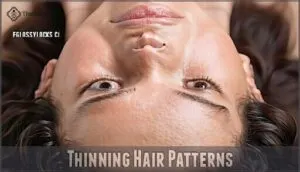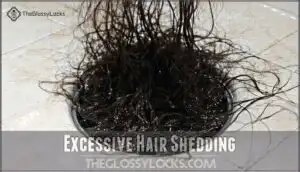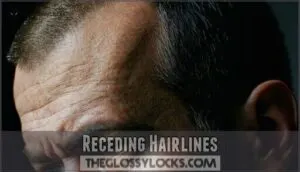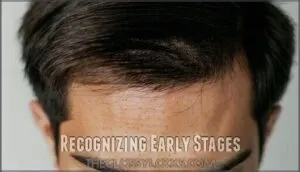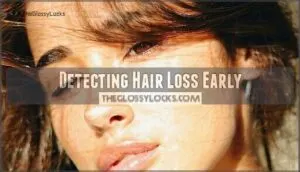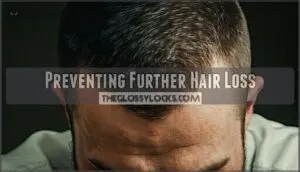This site is supported by our readers. We may earn a commission, at no cost to you, if you purchase through links.

Watch for thinning at your crown or temples, a receding hairline, or your part becoming wider than usual.
Excessive shedding—more than 100 hairs daily—signals potential trouble, especially if you’re finding clumps on your pillow or in the shower drain.
Your ponytail might feel thinner, or you’ll see more scalp through your hair when styling, which can be an indication of diffuse thinning.
Women often experience diffuse thinning across the top, while men typically develop an M-shaped hairline pattern.
The key lies in catching these subtle shifts before they become obvious bald patches.
Table Of Contents
- Key Takeaways
- Early Hair Loss Signs
- Hair Loss Causes Explained
- Recognizing Early Stages
- Detecting Hair Loss Early
- Preventing Further Hair Loss
- Frequently Asked Questions (FAQs)
- What does the first stage of hair loss look like?
- How do I stop my hair from falling?
- What is stage 1 hair loss?
- At what age does hair loss start?
- Can genetics alone determine hair loss outcome?
- When should teenagers worry about hair thinning?
- Do certain medications accelerate hair loss progression?
- How does seasonal change affect hair shedding?
- Can tight hairstyles cause permanent hair damage?
- Conclusion
Key Takeaways
- Watch for gradual thinning patterns – You’ll notice more scalp showing through your part, temple recession, or crown visibility before obvious bald spots develop, so monitor these areas regularly.
- Track your daily shedding rate – If you’re losing more than 100 hairs daily or finding clumps on your pillow and shower drain instead of scattered strands, it’s time to take action.
- Don’t ignore texture and density changes – When your ponytail feels thinner, your hair looks less full when styling, or individual strands feel weaker than usual, these are early warning signs.
- Act quickly for best results – Early intervention with proper treatments, stress management, and gentle hair care gives you the highest chance of slowing or reversing hair loss before it becomes severe.
Early Hair Loss Signs
You might notice your hair looking thinner around the crown or temples before obvious bald spots appear.
Catching these subtle changes early—like finding more hair on your pillow or shower drain—gives you the best chance to slow or reverse the process.
Thinning Hair Patterns
Throughout your scalp and crown, thinning hair patterns reveal themselves before obvious bald spots appear.
You’ll notice diffuse thinning across your entire head—hair density decreases by 20-50% before becoming visually apparent.
Your part line widens substantially, and crown visibility increases as follicles miniaturize.
These early balding patterns require immediate attention for effective hair thinning solutions.
Excessive Hair Shedding
Beyond noticing general thinning patterns, you’ll want to watch your shedding rate closely. Normal hair loss ranges from 50-100 strands daily, but excessive hair shedding signals potential trouble ahead.
Your hair becomes your detective—count the clues before the case goes cold.
Key signs of problematic hair shedding:
- Dramatic shower drain clogs – Finding clumps instead of scattered strands
- Pillow covered in hair – Waking up to noticeable hair on bedding
- Brush overload – Collecting substantially more hair than usual during styling
- Seasonal shedding extremes – Losing far more than typical autumn increases
Telogen effluvium, postpartum shedding, and medication effects can trigger temporary excessive hair loss. However, persistent high shedding rates often indicate early signs of hair loss requiring attention. Track your daily loss patterns – counting strands might seem tedious, but it’s your best defense against missing these vital hair loss symptoms before permanent thinning begins.
Receding Hairlines
If you notice your hairline shifting back or forming a Widows Peak, that’s a classic receding hairline—one of the earliest signs of hair loss.
Temple recession and changes in Hairline Shapes signal balding signs.
Keep an eye on Hair Density. Early detection opens the door to Treatment Options, giving you a fighting chance before things get hairy.
This can be attributed to male pattern hair loss.
Hair Loss in Women
While receding hairlines affect men primarily, women face unique challenges with Female Pattern Baldness. Unlike male hair loss, female hair loss often presents as overall thinning rather than distinct bald spots, making early signs harder to detect.
Women’s hair loss patterns include:
- Widening part lines that reveal more scalp
- Thinning around the crown area
- Reduced hair volume despite same length
- Increased hair fall during washing or brushing
- Noticeable scalp visibility in bright lighting
The Hair Loss Stigma surrounding alopecia symptoms in women creates significant Emotional Impact. Many delay seeking treatment due to societal expectations. Fortunately, Cosmetic Solutions like Wigs and Hairpieces offer immediate confidence while addressing underlying causes.
Hair Loss Causes Explained
Understanding what causes your hair to thin helps you address the problem before it becomes severe.
Your genes, hormones, stress levels, and daily habits all play vital roles in determining whether you’ll experience hair loss and how quickly it progresses, influenced by factors such as hormones.
Key Trends Shaping Industry
The hair loss industry’s experiencing unprecedented transformation through technological advancements and evolving consumer behavior.
Market expansion now targets younger demographics seeking early detection methods for thinning hair patterns, while globalization impacts bring new treatment options worldwide.
| Trend Category | Key Development |
|---|---|
| Technology | AI-powered scalp imaging achieves 87% accuracy in early signs detection |
| Market Growth | Global treatment market reached $8.9B in 2024 |
| Consumer Shift | 57% seek preventive care before visible hair loss |
| Demographics | Women now represent 38% of spending, up from 24% |
| Digital Health | 62% of consultations start via digital platforms |
Major Challenges Ahead
You’ll face significant obstacles in addressing hair loss prevention effectively.
Treatment accessibility remains limited, with many patients unable to afford specialized care or locate qualified dermatologists.
Research funding continues declining, slowing innovation pipeline development for new therapies.
Public awareness campaigns struggle against persistent stigma reduction barriers, preventing early detection discussions.
- Financial barriers block 60% of people from seeking early hair loss treatment
- Limited specialists mean 3-month waiting periods for thinning hair consultations
- Insurance denials leave patients paying $200+ monthly for prevention medications
- Rural communities lack access to advanced hair loss diagnostic equipment
- Workplace discrimination fears prevent open discussions about early signs
Emerging Opportunities Today
Today’s advances open exciting pathways for early hair loss prevention.
Telehealth options connect you with specialists from home, while genetic research reveals personalized solutions customized to your DNA.
Future treatments using stem cells and regenerative medicine show promise in clinical trials.
Preventative strategies now target early signs before visible thinning occurs, making hair loss diagnosis more precise and early intervention more effective, with a focus on early hair loss prevention.
Recognizing Early Stages
You’ll want to catch hair loss before it becomes obvious, since early intervention works best.
Recognizing subtle changes in your hair’s thickness, growth patterns, and overall health can help you address problems while treatment options remain most effective, and this allows for early intervention to be highly beneficial.
Identifying Hair Loss Triggers
Behind every hair loss story lies specific triggers waiting to be uncovered.
Dietary deficiencies, medication side-effects, and scalp conditions often spark early signs before you notice thinning.
Stress and hormonal changes accelerate the process, while environmental factors like harsh chemicals compound genetic predisposition.
Identifying these hair loss causes early gives you the upper hand in prevention.
Family History of Baldness
Genetic predisposition plays a vital role in determining your hair loss timeline and severity.
If baldness runs in your family, you’re likely facing increased risk for androgenetic alopecia, with up to 80% of cases showing hereditary components.
- Maternal lineage matters most – Key hair loss genes come from your mother’s X chromosome
- Early onset predicts stronger inheritance – Hair thinning before age 30 links to family history in 75% of cases
- Sibling patterns reveal risk – Brothers of bald men have 70% probability of similar loss
Hormonal Imbalance Effects
Hormonal fluctuations can trigger early signs of hair thinning beyond genetic predisposition.
The Hormone-Hair Connection involves DHT Sensitivity, where elevated dihydrotestosterone shrinks follicles in androgenetic alopecia.
Women experience hair loss through declining Estrogen Levels during menopause or PCOS Hairloss from excess androgens.
Thyroid Impact disrupts growth cycles, causing diffuse thinning.
Watch for widening parts or increased shedding—your hormones might be the culprit.
High levels of androgens can affect sex-specific hair growth.
Stress and Hair Loss
Beyond hormonal factors, stress acts as a silent saboteur of your hair health.
Chronic stress triggers Telogen Effluvium, pushing hair follicles into early resting phases. This stress mechanism also contributes to Alopecia Areata, creating patchy hair loss patterns.
You’ll notice early signs like increased shedding during stressful periods. Effective stress management techniques can promote hair regrowth and prevent further damage, leading to overall hair health.
Detecting Hair Loss Early
You can catch hair loss before it becomes noticeable by tracking your hair’s normal shedding patterns and watching for subtle changes in thickness or texture.
The key is knowing what to look for and when to seek professional guidance, since early detection gives you the best chance to slow or reverse the process, which is crucial for effective treatment.
Monitoring Hair Growth Cycles
Understanding your hair growth cycle helps you catch early signs of thinning before it becomes noticeable.
Each follicle follows a predictable pattern, making changes easier to track.
Key monitoring strategies include:
- Cycle Length Variation – Notice if growth phases become shorter over time
- Growth Phase Duration – Track how long hair stays in active growth
- Shedding Rate Analysis – Count daily hair loss during washing and brushing
Follicle Miniaturization Tracking and Seasonal Growth Impact affect early detection timing.
Noticing Early Warning Signs
You’ll notice early warning signs through Subtle Changes in your daily routine.
Hair texture changes become apparent when strands feel thinner or weaker than usual. Scalp Changes include increased visibility of your scalp through parted hair.
Density Decline appears as less fullness when styling. Growth Slowdown means longer periods between cuts, while early symptoms manifest as more hair on pillows or shower drains than normal, indicating a potential Growth Slowdown.
Using Hair Loss Diagnostic Tools
When technology meets your hairline, you’re looking at the future of early detection.
Digital scalp analysis tools can spot hair density changes as small as 10%, while trichoscopy reveals miniaturized follicles that signal androgenetic alopecia’s arrival.
Modern microscopic evaluation systems boost diagnostic accuracy by 25%, making tool accuracy your secret weapon against progressive thinning patterns.
Addressing Malassezia yeast overgrowth can also improve scalp conditions.
Consulting a Dermatologist
Professional dermatologists bring specialized training to accurately diagnose your early hair loss patterns.
Their dermatology expertise allows precise identification of conditions like androgenetic alopecia versus telogen effluvium.
You’ll receive personalized care plans with evidence-based treatment options ranging from topical medications to advanced therapies.
Many patients also seek specialized product options for their hair loss needs.
Regular follow-up care confirms your progress stays on track, giving you the best shot at preserving your hair with evidence-based treatment.
Preventing Further Hair Loss
Once you’ve spotted early hair loss signs, taking swift action can slow or halt further thinning through targeted lifestyle changes and medical interventions.
The earlier you start prevention strategies, the better your chances of maintaining your current hair density and potentially reversing some damage, which can be achieved through targeted lifestyle changes.
Maintaining a Healthy Diet
Nutrition directly impacts hair health, making balanced meals your first defense against hair fall.
Nutrient deficiencies in iron, zinc, and biotin trigger early signs of thinning. Boost protein intake through lean meats, eggs, and legumes—your follicles need amino acids to produce strong strands.
Hydration importance can’t be overstated; dehydration weakens hair structure. Consider vitamin supplements if your diet lacks essential nutrients.
Some people also find hair growth support beneficial. Proper nutrition forms the foundation of effective hair loss prevention strategies.
Reducing Stress and Anxiety
Chronic stress acts like kryptonite to your hair follicles, disrupting natural growth cycles and accelerating early signs of hair loss.
Stress doesn’t just mess with your mood—it literally starves your hair follicles of what they need to thrive.
Managing stress isn’t just about feeling better—it’s essential hair loss prevention that can literally save your strands.
- Mindfulness techniques: Practice 10-minute daily meditation to lower cortisol levels that trigger hair thinning
- Relaxation exercises: Try progressive muscle relaxation before bed to improve sleep quality and hormone balance
- Stress management: Schedule regular breaks during work to prevent anxiety buildup that affects scalp circulation
- Lifestyle changes: Incorporate yoga or walking into your routine for natural anxiety reduction and better blood flow
Using Gentle Hair Care Products
Beyond managing stress levels, you’ll want to choose hair care products that won’t aggravate existing early signs of hair loss.
Sulfate-free shampoos with natural ingredients protect scalp health while preventing hair breakage. Many consumers are now switching to gentle sulfate-free options to avoid irritation.
Gentle brushing techniques and avoiding product build-up help preserve thinning hair remedies’ effectiveness.
| Product Type | Gentle Options | Benefits |
|---|---|---|
| Shampoo | Sulfate-free formulas | Reduces scalp irritation |
| Conditioner | Lightweight, natural ingredients | Prevents hair breakage |
| Styling Products | Alcohol-free options | Minimizes product build-up |
| Tools | Wide-tooth combs | Gentle brushing without damage |
| Treatments | Plant-based serums | Supports scalp health naturally |
Considering Medical Treatments
Hope arrives through proven medical pathways when you catch early symptoms.
Medication options like finasteride and minoxidil deliver 94% improvement rates in combination therapy.
Combined treatments are highly effective against hair loss.
Injection therapies including platelet-rich plasma boost follicle density by 31%.
Laser therapy and clinical trials offer additional hair loss solutions, while surgical restoration provides lasting results when other treatments plateau.
Frequently Asked Questions (FAQs)
What does the first stage of hair loss look like?
Your hairline’s practically screaming for attention.
You’ll notice increased shedding during washing, subtle thinning at temples, wider part lines, and more scalp visibility.
The crown area typically starts showing through first, with increased shedding and subtle thinning being key indicators.
How do I stop my hair from falling?
You can manage hair loss by using gentle shampoo, taking prescribed medications like minoxidil, eating protein-rich foods, managing stress effectively, and consulting dermatologists for personalized treatment options.
What is stage 1 hair loss?
Stage 1 hair loss involves minimal thinning at your temples and crown.
You’ll notice increased shedding, shorter hair cycles, and subtle recession.
Most people don’t recognize it immediately since changes appear gradual.
At what age does hair loss start?
You’ll start thinning earlier or later depending on genetics, hormones, and lifestyle factors.
Men might notice changes as early as 15-16 years old, though most show signs by
Women typically experience noticeable hair loss around 50, with 40% affected by that age.
Your genetic blueprint holds the timeline.
For men, visible hair loss is common by age 20, which can be influenced by various lifestyle factors.
Can genetics alone determine hair loss outcome?
Genetics substantially influence your hair loss pattern and timing, but they don’t seal your fate completely.
Lifestyle factors, hormones, stress, and medical treatments can modify genetic predisposition, offering hope for intervention.
When should teenagers worry about hair thinning?
You shouldn’t panic at the first sign of thinning—it’s often temporary stress or styling damage.
However, if you’re noticing consistent pattern baldness or significant shedding lasting months, consult a dermatologist for early intervention options.
Do certain medications accelerate hair loss progression?
Like fuel feeding a fire, certain medications can accelerate your hair loss journey.
Blood thinners, antidepressants, chemotherapy drugs, and high-dose vitamin A supplements commonly trigger telogen effluvium, pushing follicles into premature shedding phases and worsening existing androgenetic alopecia patterns.
How does seasonal change affect hair shedding?
Seasonal changes trigger natural shedding cycles—you’ll notice more hair loss during fall and spring periods.
Your follicles respond to shifting daylight and temperature, causing temporary increased shedding that typically normalizes within weeks, related to the natural shedding cycles.
Can tight hairstyles cause permanent hair damage?
Tugging and pulling your follicles like puppet strings, tight hairstyles can indeed cause permanent damage called traction alopecia. You’ll notice thinning around your hairline first. Loosen up regularly!
Conclusion
Recognizing these early signs of hair loss isn’t rocket science—it’s absolutely vital for preserving your crowning glory.
You’ve learned to spot thinning patterns, excessive shedding, and receding hairlines before they become major concerns.
Don’t wait until you’re staring at significant bald patches in the mirror.
Take action now by monitoring your hair’s health, consulting professionals when needed, and implementing preventive measures.
Early detection gives you the best chance to maintain your hair’s thickness and confidence.
- https://docs.google.com/forms/d/1GAQr3Kn1cURCVHUA82hAga1Wv8DCH0IuqDLRUrOpN7M/viewform?ts=63f4f653&entry.1515682415=https://www.merriam-webster.com/dictionary%2Fearly
- https://premium.britannica.com/mw-unabridged/?utm_source=mw&utm_medium=inline-def&utm_campaign=evergreen
- https://dictionary.cambridge.org/us/dictionary/english/ahead?topic=early
- https://ar.thefreedictionary.com/%d8%a8%d9%8e%d8%a7%d9%83%d9%90%d8%b1%d8%a7%d9%8b
- https://fr.thefreedictionary.com/t%c3%b4t

